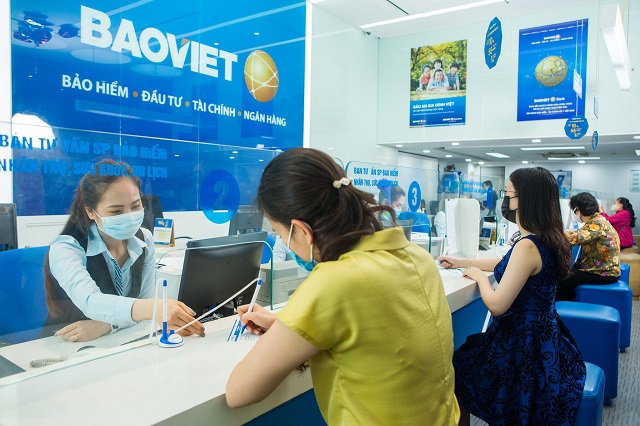 Economy
Economy


|
| Inside a transaction office of Bảo Việt Holdings. Photo baoviet.com.vn |
HÀ NỘI — Accelerating the digital transformation process not only helps insurance businesses transform during the COVID-19 pandemic but also is considered the foundation for growth in the economic recovery.
With the current push in digital transformation, experts from SSI Securities Corporation believe that E-insurance certificates will gradually be legalised for other insurance products, such as health insurance and property damage insurance. Therefore, sales through online channels will also gradually grow.
Besides being a key driver of the recovery in demand, premium revenue growth could come from partnering with fintech companies to boost innovation in data analysis, helping insurance companies diversify products and distribution channels in the future.
Previously, premium revenue growth was hit hard by strict social distancing orders.
Data from SSI show that in the third quarter of 2021, gross written premium (GWP) and new business premium (NBP) of life insurance recorded the lowest growth rate ever, up 8.5 per cent year-on-year and negative 10.5 per cent, respectively.
Non-life insurance premium revenue decreased by 12 per cent compared to the same period of 2020.
Some stages in the life insurance sales process such as health checks and buyers’ direct signatures have been interrupted during social distancing, affecting revenues of life insurance businesses.
For non-life insurance, the demand for auto insurance, personal accident insurance and travel insurance, which normally contribute about 50 per cent of total premium revenue, was low during the period.
According to experts from SSI, the use of a common database on compulsory insurance of civil liability of motor vehicle owners with motor vehicle registration information, road traffic safety violations, and traffic accident histories can help insurance companies better classify customers.
Meanwhile, Decree 3 also allows insurance companies to increase premiums by up to 15 per cent compared to the level set by the Ministry of Finance, based on the accident history of each motor vehicle and its risk tolerance capacity. This is likely to help insurers increase premiums on higher-risk contracts instead of applying the same price to all contracts as before.
Changes in regulations on electronic certificates, if any, will also have a positive impact on the online sales channel, with revenues increasing while the intermediary costs for agents and brokers may gradually decline.
Previously, insurers received positive signals from the news of State divestment and the rise of the foreign ownership ratio in insurance companies to a maximum level last August.
Accordingly, on the national investment portal, the Ministry of Planning and Investment has officially updated market access conditions for foreign investors, which clearly states the foreign owner limit (FOL) for the insurance industry is 100 per cent.
The move has removed difficulties for many insurance companies such as Bảo Minh Insurance Corporation, Post and Telecommunication Joint Stock Insurance Corporation, and Petrolimex Insurance Corporation, which raised their foreign ownership rates in recent years.
Some companies then reported to the State Securities Commission of Việt Nam (SSC) the increase of FOL to 100 per cent like PTI, or 49 per cent like Bảo Việt Holdings.
KIS Việt Nam Securities Corporation said that the general insurance market was dominated by State-owned companies. Therefore, the change in ownership structure and the penetration of foreign investors make the market's outlook more promising.
However, the securities firm warned that the low-interest-rate environment continued to be a challenge for the growth of businesses in the insurance market. — VNS




